Plastic Packaging Waste Management in Iceland: Challenges and Opportunities from a Life Cycle Assessment Perspective
Abstract
1. Introduction
2. Plastic Packaging Demand and Waste in Iceland
3. Materials and Methods
3.1. Goal and Scope of the Study
3.2. Inventory Analysis
3.2.1. Plastic Packaging Demand
3.2.2. Plastic Packaging Waste
3.2.3. Data Limitations and Assumptions of the LCA Study
4. Impact Assessment
4.1. Plastic Packaging Demand
4.2. Plastic Packaging Waste

5. Interpretation
5.1. Scenario Analysis
5.1.1. Differences in Geographical Destinations of Recyclable Plastic Packaging in 2020 and 2021
5.1.2. Recycling in Iceland
5.1.3. Combining the Results of the Impact on Plastic Demand in Iceland and the Substitution Credits of Current Recycling Rates
5.2. Sensitivity Analysis
5.2.1. Substitution Potential of Recycled Plastics
5.2.2. Transportation Distance of Plastic Wastes
6. Conclusions
Supplementary Materials
Author Contributions
Funding
Acknowledgments
Conflicts of Interest
References
- Geyer, R.; Jambeck, J.R.; Law, K.L. Production, use, and fate of all plastics ever made. Sci. Adv. 2017, 3, e1700782. [Google Scholar] [CrossRef] [PubMed]
- Li, W.C.; Tse, H.F.; Fok, L. Plastic waste in the marine environment: A review of sources, occurrence and effects. Sci. Total Environ. 2016, 566–567, 333–349. [Google Scholar] [CrossRef] [PubMed]
- Zheng, J.; Suh, S. Strategies to reduce the global carbon footprint of plastics. Nat. Clim. Chang. 2019, 9, 374–378. [Google Scholar] [CrossRef]
- Icelandic Parliament. Lög Nr. 90 7. July 2020 on Household Plastic Applications. 2020. Available online: https://www.althingi.is/altext/stjt/2020.090.html (accessed on 25 July 2021).
- European Commission. Directive (EU) 2019/904 of the European Parliament and of the Council of 5 June 2019 on the Reduction of the Impact of Certain Plastic Products on the Environment. 2021. Available online: https://eur-lex.europa.eu/eli/dir/2019/904/oj (accessed on 6 May 2022).
- Icelandic Recycling Fund. Plastic Packaging in Iceland 2020. 2022.
- Icelandic Recycling Fund. Skýrsla Um Starfsemi Úrvinnslusjóds. 2020. Available online: https://www.Urvinnslusjodur.Is/Media/Arsskyrslur/Starfsskyrsla-2020.Pdf (accessed on 5 May 2022).
- Statistics Iceland. The Population on January 1st 2019. 2020. Available online: https://statice.is/publications/news-archive/inhabitants/the-population-on-january-1st-2019/ (accessed on 5 May 2022).
- Eurostat. Packaging Waste by Waste Management Operations. Online Data Code: ENV_WASPAC. 2022. Available online: http://appsso.eurostat.ec.europa.eu/nui/show.do?lang=en&dataset=env_waspac (accessed on 25 March 2022).
- Environment Agency of Iceland. Plastic Packaging in Iceland 2020. E-Mail Correspondence. 2021. [Google Scholar]
- Plastics Europe. Plastic—The Facts 2021. E-Mail Correspondence. 2022. [Google Scholar]
- Plastics Europe. Plastics—The Facts 2021 • Plastics Europe. 2022. Available online: https://plasticseurope.org/knowledge-hub/plastics-the-facts-2021/ (accessed on 7 June 2022).
- European Commission. Regulation (EC) No 2150/2002 of the European Parliament and of the Council of 25 November 2002 on Waste Statistics. 2002. Available online: https://eur-lex.europa.eu/legal-content/en/ALL/?uri=CELEX%3A32002R2150 (accessed on 27 May 2022).
- Statistics Iceland. The population of Iceland on January 1, 2021. 2021. Available online: https://www.statice.is/publications/news-archive/inhabitants/the-population-on-january-1st-2021/ (accessed on 7 May 2022).
- Plastics Europe. Quarterly Report Q3/2021. European Plastics Manufacturers (EU 27). 2022. [Google Scholar]
- Sarmento, P.; Motta, M.; Scott, I.J.; Pinheiro, F.L.; de Castro Neto, M. Impact of COVID-19 lockdown measures on waste production behavior in Lisbon. Waste Manag. 2022, 138, 189–198. [Google Scholar] [CrossRef] [PubMed]
- Fogt Jacobsen, L.; Pedersen, S.; Thøgersen, J. Drivers of and barriers to consumers’ plastic packaging waste avoidance and recycling—A systematic literature review. Waste Manag. 2022, 141, 63–78. [Google Scholar] [CrossRef] [PubMed]
- Endurvinnslan. Deposit System in Iceland. 2022. Available online: http://endurvinnslan.is/English/ (accessed on 7 June 2022).
- Úrvinnslusjóður. Icelandic Recycling Fund Heyrúlluplast. 2022. Available online: https://www.urvinnslusjodur.is/Voruflokkar/Heyrulluplast/ (accessed on 7 June 2022).
- Environment Agency of Iceland. Operation Permit for Handling the Wastes to SORPA. 2020. Available online: https://Ust.Is/Library/Sida/Atvinnulif/Starfsleyfi-Og-Eftirlitsskyrslur/SORPA%20-%20undirrita%c3%b0.Pdf (accessed on 20 July 2022).
- DIN EN ISO 14040. Environmental Management—Life Cycle Assessment—Principles and Framework (ISO 14040:2006 + Amd 1:2020). German Version EN ISO 14040:2006 + A1:2020. 2021. Available online: https://www.din.de/de/mitwirken/normenausschuesse/nagus/veroeffentlichungen/wdc-beuth:din21:325953744 (accessed on 4 February 2022).
- DIN EN ISO 14044. Environmental Management—Life cycle Assessment—Requirements and Guidelines (ISO 14044:2006 + Amd 1:2017 + Amd 2:2020). German Version EN ISO 14044:2006 + A1:2018 + A2:2020. 2021. Available online: https://www.din.de/de/mitwirken/normenausschuesse/nagus/veroeffentlichungen/wdc-beuth:din21:325953813 (accessed on 4 February 2022).
- European Commission; Joint Research Centre; Institute for Environment and Sustainability. International Reference Life Cycle Data System (ILCD) Handbook: General Guide for Life Cycle Assessment Detailed Guidance; Publications Office of the European Union: Luxembourg, 2010. [Google Scholar]
- European Commission; Joint Research Centre; Institute for Environment and Sustainability. International Reference Life Cycle Data System (ILCD) Handbook Framework and Requirements for Life Cycle Impact Assessment Models and Indicators; Publications Office of the European Union: Luxembourg, 2010. [Google Scholar]
- Sphera. GaBi LCA Software. 2022. Available online: https://gabi.sphera.com/deutsch/index/ (accessed on 24 June 2022).
- Sphera. GaBi Data Search. 2022. Available online: https://gabi.sphera.com/Databases/Gabi-Data-Search/ (accessed on 24 June 2022).
- Leiden University. CML-IA Characterisation Factors. 2016. Available online: https://www.universiteitleiden.nl/en/research/research-output/science/cml-ia-characterisation-factors (accessed on 14 June 2022).
- EcoTransIT World. Emission Calculator for Greenhouse Gases and Exhaust Emissions. 2021. Available online: https://www.ecotransit.org/en/ (accessed on 7 June 2022).
- Nessi, S.; Sinkko, T.; Bulgheroni, C.; Garcia-Gutierrez, P.; Giuntoli, J.; Konti, A.; Sanye Mengual, E.; Tonini, D.; Pant, R.; Marelli, L.; et al. Life Cycle Assessment (LCA) of Alternative Feedstocks for Plastics Production; EUR 30725 EN; Publications Office of the European Union: Luxembourg, 2021. [Google Scholar]
- Pure North. Plastic Type Silage Film. E-Mail Correspondence. 2022. [Google Scholar]
- Scheutz, C.; Kjeld, A.; Fredenslund, A.M. Methane emissions from Icelandic landfills—A comparison between measured and modelled emissions. Waste Manag. 2022, 139, 136–145. [Google Scholar] [CrossRef] [PubMed]
- Gulbrsansen, L.K.; Jacob, M. Nordic Costal Clean Up 2017 Report; European Commission: Brussels, Belgium, 2018; Available online: https://publications.jrc.ec.europa.eu/repository/handle/JRC125046 (accessed on 15 November 2022).
- de Sadeleer, I.; Aksham, C.; Stensgård, A.E.; Baxter, J. Integration of Plastic Littering in LCA Methodology and Eco-Design Tips for the Avoidance of Littering; Norwegian Institute for Sustainability Research: Kråkerøy, Norway, 2021; Available online: https://norsus.no/wp-content/uploads/OR.08.21.pdf (accessed on 15 November 2022).
- Icelandic Recycling Fund. Tollskra. Available online: https://vefskil.tollur.is/Tollalinan/Tav/ (accessed on 5 May 2022).
- Clarke, J.; Heinonen, J.; Ottelin, J. Emissions in a decarbonised economy? Global lessons from a carbon footprint analysis of Iceland. J. Clean. Prod. 2017, 166, 1175–1186. [Google Scholar] [CrossRef]
- Chen, Y.; Cui, Z.; Cui, X.; Liu, W.; Wang, X.; Li, X.; Li, S. Life cycle assessment of end-of-life treatments of waste plastics in China, Resources. Conserv. Recycl. 2019, 146, 348–357. [Google Scholar] [CrossRef]
- Al-Maaded, M.; Madi, N.K.; Kahraman, R.; Hodzic, A.; Ozerkan, N.G. An Overview of Solid Waste Management and Plastic Recycling in Qatar. J. Polym. Environ. 2012, 20, 186–194. [Google Scholar] [CrossRef]
- Al-Salem, S.M.; Evangelisti, S.; Lettieri, P. Life cycle assessment of alternative technologies for municipal solid waste and plastic solid waste management in the Greater London area. Chem. Eng. J. 2014, 244, 391–402. [Google Scholar] [CrossRef]
- Helmes, R.J.K.; Goglio, P.; Salomoni, S.; van Es, D.S.; Vural Gursel, I.; Aramyan, L. Environmental Impacts of End-of-Life Options of Biobased and Fossil-Based Polyethylene Terephthalate and High-Density Polyethylene Packaging. Sustainability 2022, 14, 11550. [Google Scholar] [CrossRef]
- Hou, P.; Xu, Y.; Taiebat, M.; Lastoskie, C.; Miller, S.A.; Xu, M. Life cycle assessment of end-of-life treatments for plastic film waste. J. Clean. Prod. 2018, 201, 1052–1060. [Google Scholar] [CrossRef]
- Kristjansdottir, T.; Jonsdottir, H. Life Cycle Analysis of Nesjavellir Geothermal Power Plant. Available online: https://orkustofnun.is/gogn/Orkusjodur/Orkusjodur-58-Life-cycle-analysis-of-Nesjavellir.pdf (accessed on 5 May 2022).
- Kristmannsdóttir, H.; Sigurgeirsson, M.; Ármannsson, H.; Hjartarson, H.; Ólafsson, M. Sulfur gas emissions from geothermal power plants in Iceland. Geothermics 2000, 29, 525–538. [Google Scholar] [CrossRef]
- European Commission. Directive (EU) 2018/852 of the European Parliament and of the Council of 30 May 2018 Amending Directive 94/62/EC on Packaging and Packaging Waste (Text with EEA Relevance). 2022. Available online: https://eur-lex.europa.eu/legal-content/EN/TXT/?uri=celex:32018L0852 (accessed on 13 June 2022).
- Antonopoulos, I.; Faraca, G.; Tonini, D. Recycling of post-consumer plastic packaging waste in the EU: Recovery rates, material flows, and barriers. Waste Manag. 2021, 126, 694–705. [Google Scholar] [CrossRef] [PubMed]
- Tallentire, C.W.; Steubing, B. The environmental benefits of improving packaging waste collection in Europe. Waste Manag. 2020, 103, 426–436. [Google Scholar] [CrossRef] [PubMed]
- Raghab, S.M.; Abd El Meguid, A.M.; Hegazi, H.A. Treatment of Leachate from Municipal Solid Waste Landfill. HBRC J. 2013, 9, 187–192. [Google Scholar] [CrossRef]
- Plastics Europe Eco-Profiles and Environmental Declarations of the European Plastics Manufacturers, Version 3.0. 2019. Available online: https://www.plasticseurope.org/en/resources/eco-profiles (accessed on 6 May 2022).
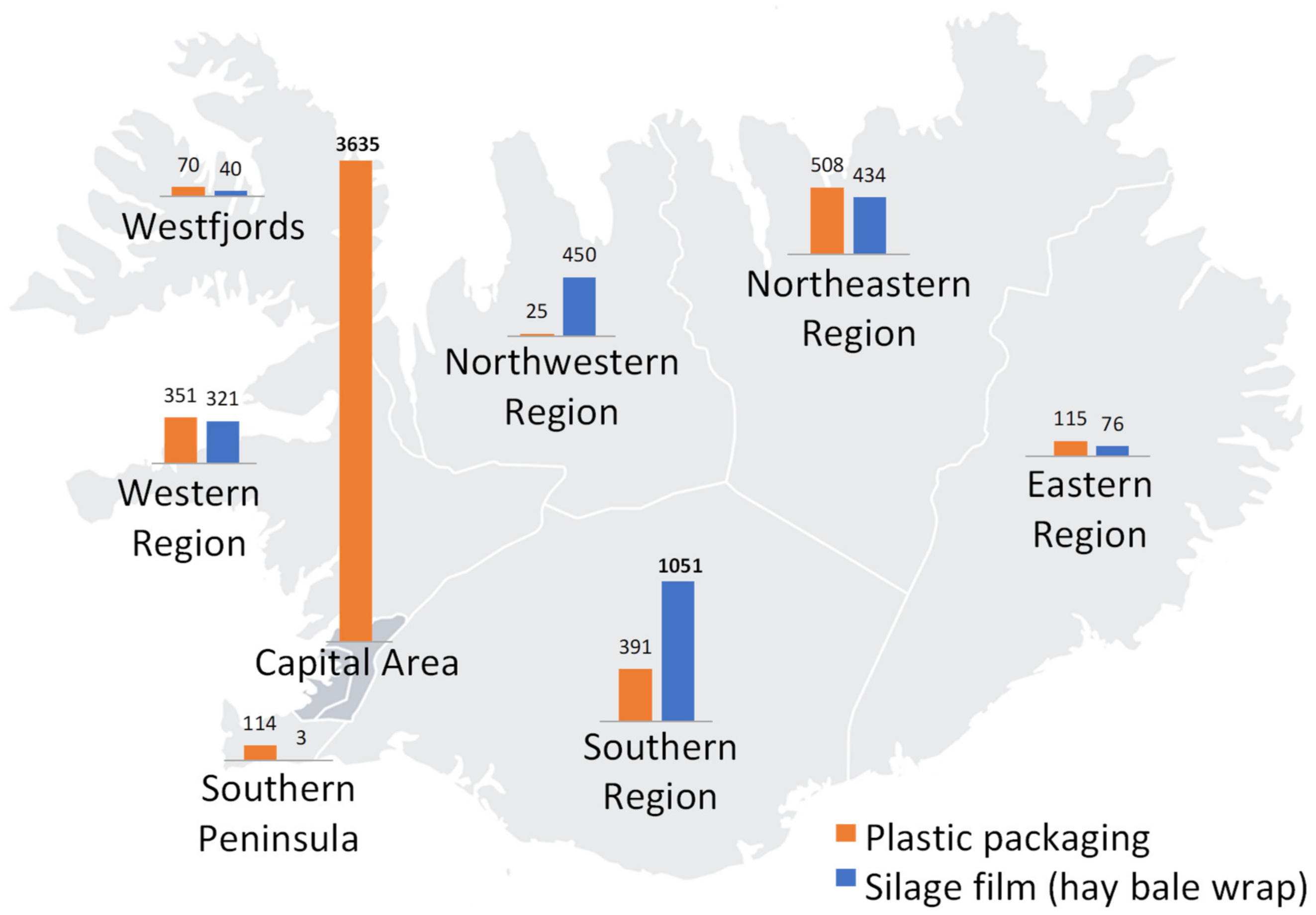
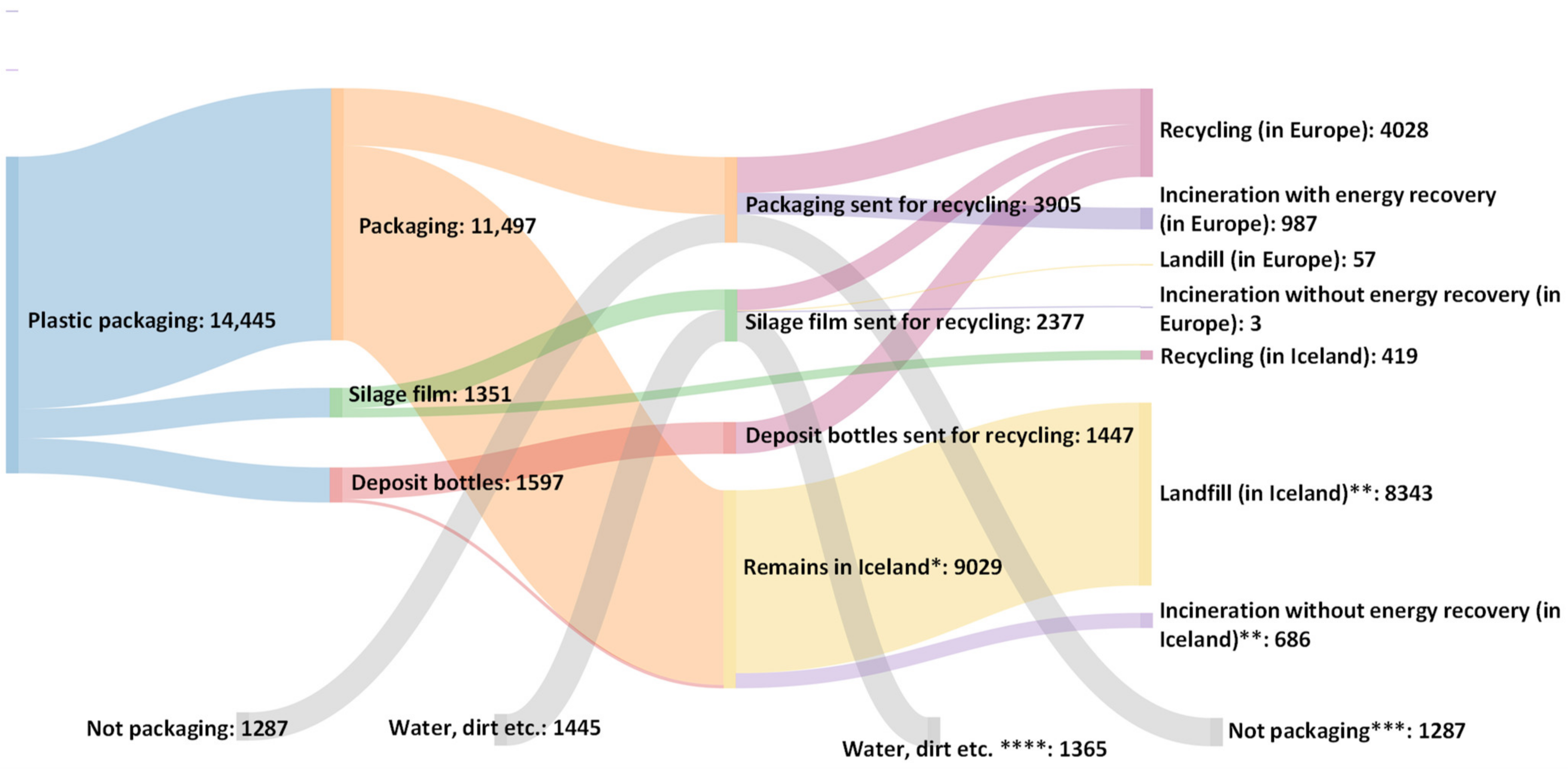
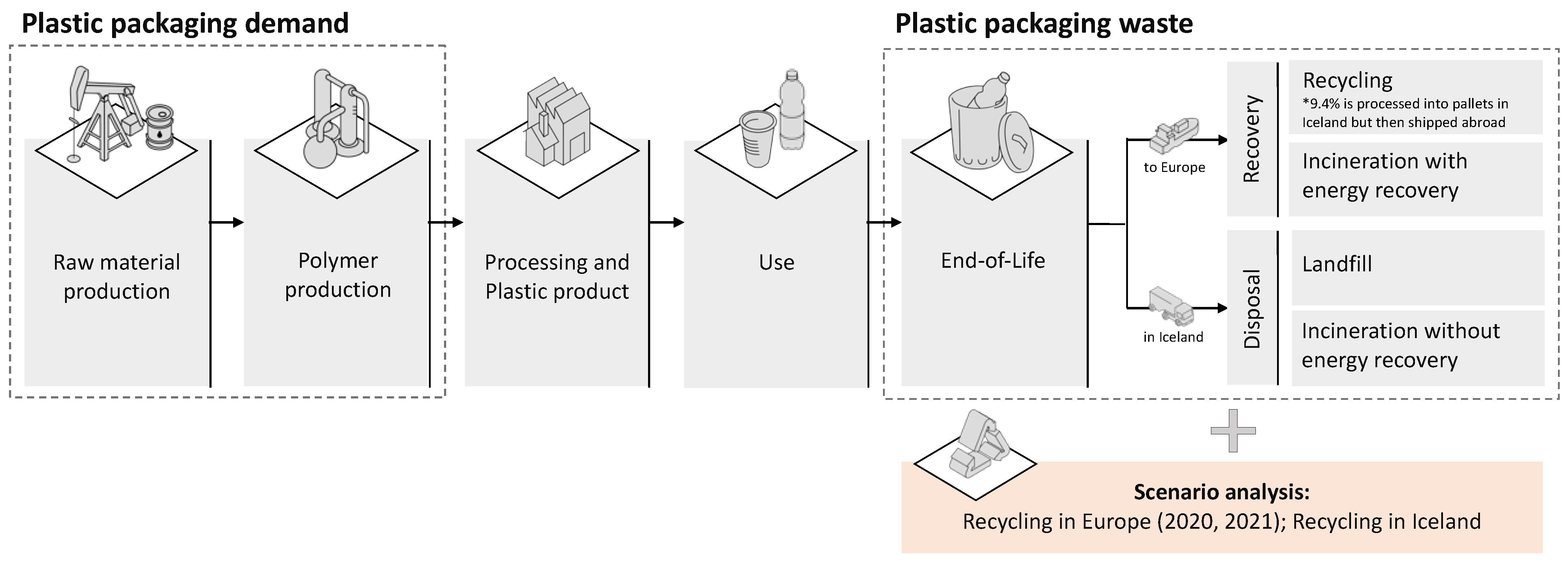

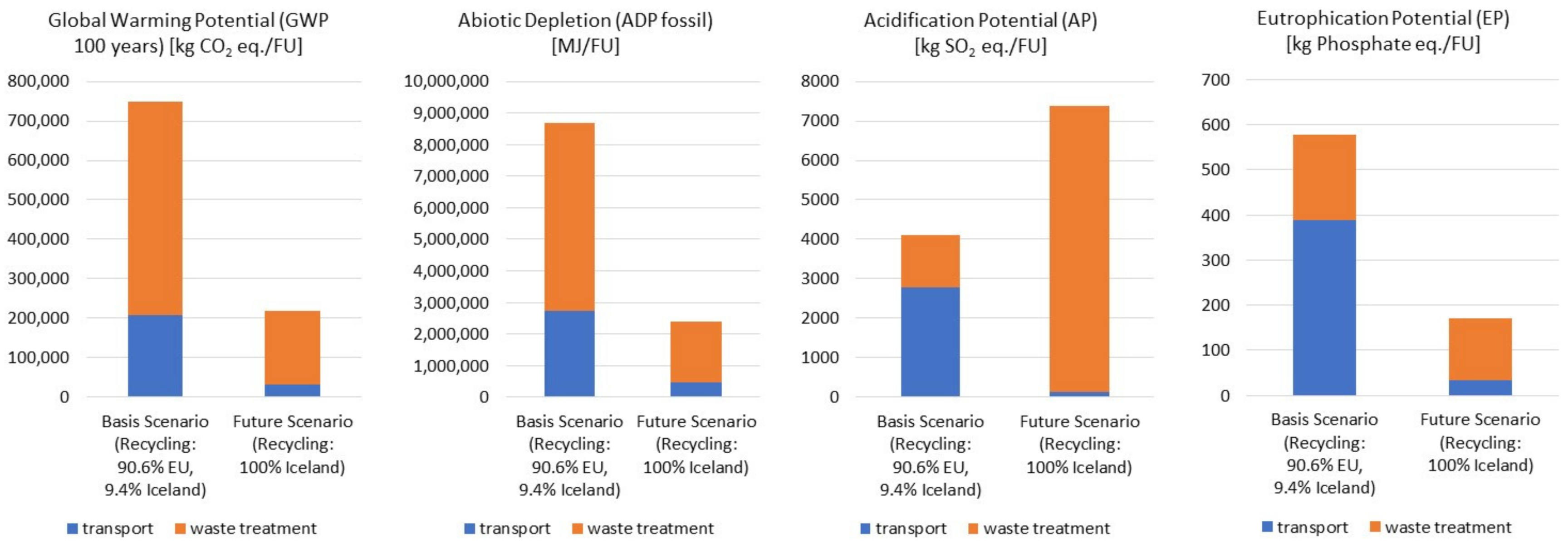
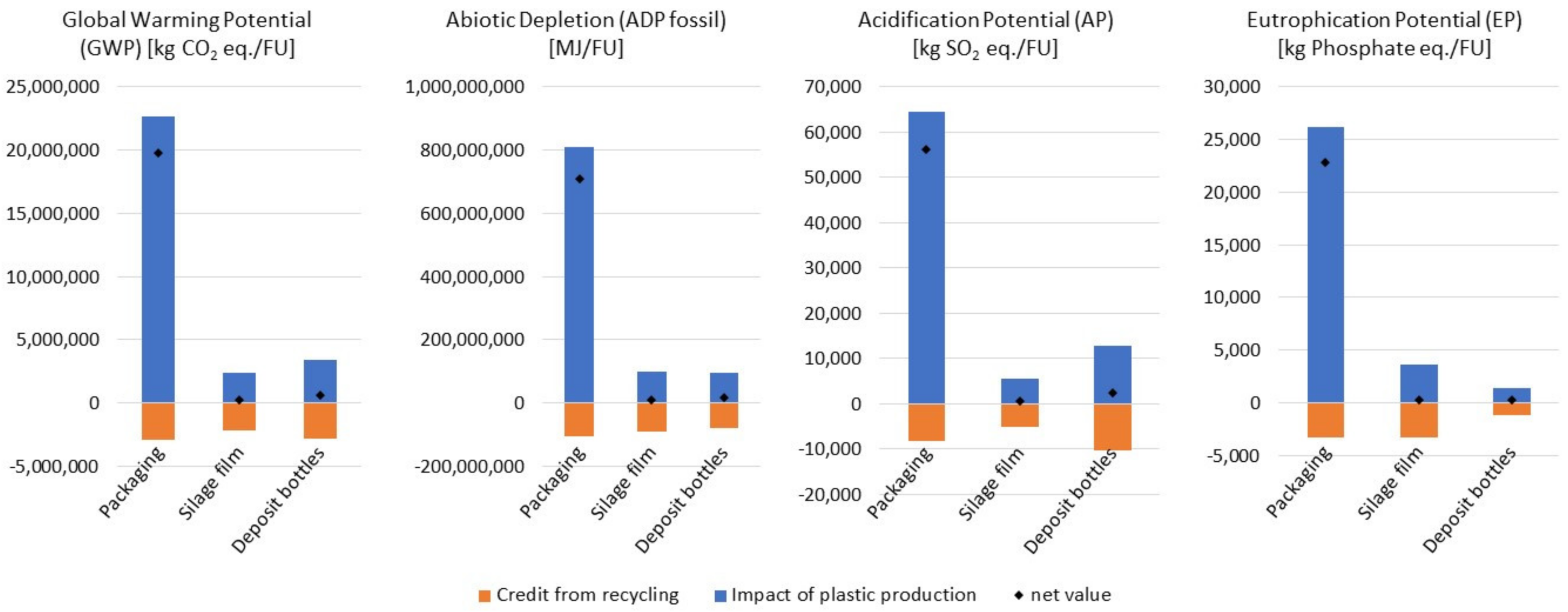

| Overview of Data | Origin | Geographical Distribution | Sources |
|---|---|---|---|
| Plastic packaging demand | Importers of goods and local plastic packaging producers | Whole Iceland | IRF [7] |
| Plastic waste statistics, including destinations for end-of-life treatments | Waste handlers | Whole Iceland | IRF [7] |
| Plastic composition | Unknown for Iceland | European average | Plastics Europe [11,12] |
| Plastic Packaging Waste Sent to | 2020 | 2021 | Average (2020 and 2022) |
|---|---|---|---|
| Sweden | 46.4% | 21.6% | 34.2% |
| Netherlands | 42.2% | 26.8% | 34.6% |
| Germany | 8.3% | 25.6% | 16.8% |
| Poland | 0.4% | 9.2% | 4.8% |
| Denmark | 0.0% | 0.7% | 0.3% |
| Recycled pellets sent to | |||
| Great Britain | 2.3% | 16.1% | 9.1% |
| China | 0.4% | 0.0% | 0.2% |
| Impacts | Recycling (Basis Scenario) | Recycling (Truck Transportation Distance Changed) | Percentage Increase | |
|---|---|---|---|---|
| Abiotic Depletion (ADP fossil) (MJ) | transport | 2.73 × 106 | 5.08 × 106 | 86% |
| waste treatment | 5.97 × 106 | 5.97 × 106 | ||
| credits | −2.17 × 108 | −2.17 × 108 | ||
| net value | −2.08 × 108 | −2.06 × 108 | 1% | |
| Acidification Potential (AP) (kg SO2 eq.) | transport | 2.79 × 103 | 3.4 × 103 | 25% |
| waste treatment | 1.32 × 103 | 1.32 × 103 | ||
| credits | −2.06 × 104 | −2.06 × 104 | ||
| net value | −1.65 × 104 | −1.58 × 104 | 4% | |
| Eutrophication Potential (EP) (kg Phosphate eq.) | transport | 3.88 × 102 | 5.65 × 102 | 46% |
| waste treatment | 1.91 × 102 | 1.91 × 102 | ||
| credits | −5.74 × 103 | −5.74 × 103 | ||
| net value | −5.16 × 103 | −4.98 × 103 | 3% | |
| Global Warming Potential (GWP 100 years) (kg CO2 eq.) | transport | 2.09 × 105 | 3.82 × 105 | 83% |
| waste treatment | 5.40 × 105 | 5.40 × 105 | ||
| credits | −6.54 × 106 | −6.54 × 106 | ||
| net value | −5.79 × 106 | −5.62 × 106 | 3% |
Publisher’s Note: MDPI stays neutral with regard to jurisdictional claims in published maps and institutional affiliations. |
© 2022 by the authors. Licensee MDPI, Basel, Switzerland. This article is an open access article distributed under the terms and conditions of the Creative Commons Attribution (CC BY) license (https://creativecommons.org/licenses/by/4.0/).
Share and Cite
Ögmundarson, Ó.; Kalweit, L.S.; Venkatachalam, V.; Kristjánsdóttir, R.; Endres, H.-J.; Spierling, S. Plastic Packaging Waste Management in Iceland: Challenges and Opportunities from a Life Cycle Assessment Perspective. Sustainability 2022, 14, 16837. https://doi.org/10.3390/su142416837
Ögmundarson Ó, Kalweit LS, Venkatachalam V, Kristjánsdóttir R, Endres H-J, Spierling S. Plastic Packaging Waste Management in Iceland: Challenges and Opportunities from a Life Cycle Assessment Perspective. Sustainability. 2022; 14(24):16837. https://doi.org/10.3390/su142416837
Chicago/Turabian StyleÖgmundarson, Ólafur, Laura Sophie Kalweit, Venkateshwaran Venkatachalam, Rakel Kristjánsdóttir, Hans-Josef Endres, and Sebastian Spierling. 2022. "Plastic Packaging Waste Management in Iceland: Challenges and Opportunities from a Life Cycle Assessment Perspective" Sustainability 14, no. 24: 16837. https://doi.org/10.3390/su142416837
APA StyleÖgmundarson, Ó., Kalweit, L. S., Venkatachalam, V., Kristjánsdóttir, R., Endres, H.-J., & Spierling, S. (2022). Plastic Packaging Waste Management in Iceland: Challenges and Opportunities from a Life Cycle Assessment Perspective. Sustainability, 14(24), 16837. https://doi.org/10.3390/su142416837








